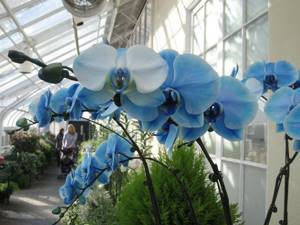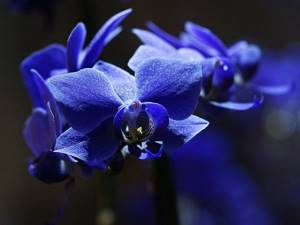Orchids are very frequent guests on our windowsills. There are a huge number of varieties and species of these plants .
Some of them are unpretentious in care, while others require special conditions. Some orchid lovers prefer to have unique varieties. On the shelves of regular stores blue Phalaenopsis You can read more about the only true blue phalaenopsis hybrid called Aphrodite, which was bred by Japanese breeders in this article. This article will talk specifically about painted orchids and whether it is possible to paint the plant yourself at home.
Ways to color orchids blue
There are two main ways to make orchid flowers blue. The first gives a superficial color to the petals. For this purpose, special floral aerosols are used.
The second method delivers pigment to the flower from the inside, through the plant’s conducting system. This delivery can be accomplished in two ways:
| Flower coloring method | Methodology | Evaluating effectiveness |
| Surface | · a “collar” of paper is attached to the flower under the peduncle; |
· a stream of aerosol floral paint is directed onto the petals.
· dyeing does not take much time;
· dyeing occurs without mechanical damage to tissues;
· the coloring is intense and long-lasting;
· the dye remains on the surface of the petals and does not penetrate into the tissues of other organs.
Flaws:
· Care and precision are required when spraying paint;
· flowers are painted evenly blue and look artificial;
· the lifespan of flowers decreases;
· newly blooming buds require repeating the staining procedure.
The solution is poured into a deep container;
· the pot with the orchid is placed in the solution for 15 minutes.
· the dye is delivered to the flower without mechanical damage to the tissue;
· not only processed flowers are painted, but also closed buds.
Flaws:
· orchid roots, leaves, bulbs and peduncles are painted along with the flowers;
· flowering duration decreases;
· when mixed with natural pigments in certain parts of the flower, the dye can produce brown spots;
· uniformity, intensity and color fastness depend on the chosen dye;
· the viability of the orchid decreases.
· the lower lateral bud on the peduncle is freed from the integumentary scale;
· An injection of dye is made into the kidney at an oblique angle.
· pigment is quickly delivered to the petals;
· not only processed flowers are painted, but also closed buds.
Flaws:
· infection may occur at the injection site;
· the viability of the orchid decreases sharply.
Professional florists prefer to color orchids by injection into the peduncle. Despite the risk of infection, this staining method is considered the most effective.
Important! Under no circumstances should paint be injected into the root neck of an orchid. After this procedure, in more than 90% of cases the plant dies.
Blue orchids, painted or real: do they exist in nature?
Introduction of pigment
The orchid is a rather delicate and capricious flower. If the procedure is carried out roughly, she may simply die.
Proper care of the plant after painting is also very important.
If the orchid needs help after coloring, the buds on the peduncle begin to fall off before they have time to bloom:
- it is necessary to cut off the part of the plant overflowing with dye;
- after this, the orchid is carefully removed from the pot and, trying not to damage the root system, washed with warm water;
- If bluish areas appear and traces of rot appear, the damaged areas also need to be cut off, and the sections themselves should be sprinkled with ash or cinnamon and dried well.
Blue orchids, which are sold in flower shops, invariably attract attention with the unusual color of their flowers. Here the question naturally arises: “Are blue varieties of orchids painted or real?” The answer to this question may disappoint exotic lovers, since such a natural color of the buds of this type of flower does not exist in nature.
The fact is that orchids do not have a gene that is responsible for the blue color of their petals. Therefore, if there is a blue orchid in a flower shop, then you know that the plant has been painted.
However, you can find flowers that have a blue-lilac color to their buds. In nature, the closest color to blue is found in representatives of the Vanda genus, which includes approximately 60 species. These plants produce flowers whose petals have a lilac tint, diluted with light spots.
Vanda has many hybrid forms, as it crosses well with other varieties. The result is unusual petal colors. But when buying blue orchids of the Vanda genus, you need to understand that they are very capricious in terms of care and you will have to tinker with them.
In addition to representatives of the Vanda genus, the following varieties of orchids form blue flowers:
- Cattleya orchid. If we compare it with Vanda, then this is a less whimsical plant that will be much easier to grow at home. Plants form large flowers that smell pleasant and have different colors of their petals;
- Phalaenopsis orchid. It is considered the most unpretentious indoor plant. The formation of small-sized buds is characteristic. Phalaenopsis does not produce the rich blue color that is characteristic of artificially colored flowers. A slight bluish tint will be more visible here. There are varieties whose flowers have a lilac or pink-blue tint.
For growing in an apartment or at home, Phalaenopsis is the best blue variety. Caring for it at home will be practically no different from flowers that have different petal colors. Apart from simple care and blue buds, the flower has practically no smell. Therefore, it is great for those for whom spicy scents are contraindicated.
As a result, we can conclude that in nature there are no varieties of orchids that have a rich blue color. But there are representatives of three genera whose buds have the desired shade. However, in terms of care, they will be somewhat more demanding than other representatives. You need to remember this when buying a flower for growing at home or as a gift.
For the first time in the world, blue orchids of the Phalaenopsis variety were presented at an exhibition of tropical plants, which took place in 2010 in Florida (USA). Such an unusual flower was obtained by the Silver Vase farm, which breeds orchids.
Just three months later, Phalaenopsis Royal Blue appeared. The plant was demonstrated at the FloraHolland flower competition, which is held annually in Holland.
Phalaenopsis Royal Blue was presented by the Dutch nursery “Geest Orchideeën”.
Today, manufacturers do not hide the fact that the blue orchid is not natural. After purchase, such flowers will bloom next time with white buds.
Thus, Phalaenopsis and the other blue-colored species are specially bred varieties by breeders. Therefore, to the question “do blue orchids exist or not in nature,” you know the exact answer. It's just a good marketing ploy.
Despite the fact that several varieties of blue orchids had already been bred, breeders continued to work in this direction. After many years of experimentation, luck smiled on Japanese breeders.
At an exhibition in Okinawa in 2013, the world's first Phalaenopsis orchid was presented, which had a truly rich blue hue. To get this color, scientists had to introduce the Asian Commelina gene into a white orchid of the Aphrodite variety.
The introduced gene was responsible for the blue coloring of the petals, so the hybrid was able to bloom with buds of the required shade.
This transgenic orchid is an exclusive plant and cannot yet be found on sale.
Manufacturers can paint Phalaenopsis blue, but the average person does not have this option. Therefore, in order to preserve the purchased indoor flower, it is necessary to properly care for it. After all, if the care of the blue orchid was insufficient, the buds will quickly begin to crumble.
It is worth noting that, regardless of the efforts of the florist, it will not be possible to get blue inflorescences from the flower after purchase. The fact is that in the absence of periodic tinting, the blue tint will gradually fade and over time the orchid will begin to bloom with white flowers.
The worst outcome would be the death of the plant due to severe stress. To prevent this situation, you need to know how to care for the blue miracle at home. There are several rules here, the implementation of which guarantees the health of the flower.
To revive a colored Phalaenopsis, you need to cut off the stem, which is full of dye. After this we perform the following steps:
- remove the flower from the pot. You need to act carefully so as not to damage the root system;
- After this, the orchid roots should be rinsed well in warm water. At this stage, it is easy to check each root for any puncture marks. If the paint is injected through the roots, then at the site of its introduction, areas with rotting or simply bluish areas will form;
- all damaged areas should be cut off;
- Next, the cut areas should be sprinkled with cinnamon or ash. They should dry well;
- After this, the plant can be placed in a flower pot. It is worth noting that a new substrate must be filled in the pot. It can be purchased at any flower shop.
The substrate in which the flower was previously must be thrown away. It cannot be reused, as it contains a large amount of chemically active substances and harmful components.
Such problems arise when sellers dye the flowers themselves, passing them off as Phalaenopsis Royal Blue. The price for such specimens is usually three times higher than for other orchids with a blue tint.
In this case, the risk of the plant dying after purchase is very high.
After all, the dyeing technology was not followed, and toxic substances could act as a dye (for example, blue ink from a regular ballpoint pen).
Typically, the dye is introduced into the plant through injections into the root, stem or peduncle. This procedure leads to a significant weakening of the flower, acting as stress for it.
Some sellers achieve a blue tint by watering the flower with blue-tinted water. In this case, not only the buds, but also the roots and leaves will get a blue tint. Although this is a more gentle coloring method, it is still stressful for the plant. Therefore, you should not try to get a blue orchid on your own at home by pouring dyes on it.
Now you know whether there are blue varieties of orchids in nature, and also how to follow them at home in order to preserve such a miracle for as long as possible.
From this video you will learn whether blue orchids exist in nature.
Choosing a dye for coloring an orchid
To color orchids, flower growers try to use different chemical dyes - from stationery ink to food coloring. Practice shows that plants react differently to these substances. The quality of coloring itself also differs:
- Stationery dyes (ink, ink, gouache paints, etc.). The most problematic material from a plant safety point of view. Stationery paints contain phytotoxic components - alcohols, viscosity and wettability modifiers, acids, etc. Painting with such substances is guaranteed to lead to the death of the orchid.
- Food colorings. Most often, flower growers use paint for Easter eggs. Blue colors are produced by dyes labeled E130 to E139. Most of them are products of coal processing or oil refining, and therefore are also unsafe for plant tissue.
- Floral aerosols. They have practically no phytotoxicity, since they are applied only to the surface of the petals. To paint orchids in blue shades, you can use “Spring pro florist” paint: for light blue – “Soft blue”, for blue – “Royal blue”.
- Floral liquid paints for fresh flowers. It is this product that is used by some unscrupulous orchid manufacturers to give plants rare colors. The speed and quality of dyeing are high, due to good solubility in water and rapid distribution of pigment throughout tissues. Complete coloring of the orchid flower occurs within a few hours after the injection.
Among liquid floral paints, the following have proven themselves well:
| Advantages: | ||
| Delivery of pigment through irrigation | · the dye dissolves in irrigation water; | |
| Advantages: | ||
| Pigment delivery by injection | · a special dye is drawn into the syringe; | |
| Advantages: | ||
| Name | Description | average cost |
| "Vase Color" | Dyes available in 300 ml glass bottles. They can be added to irrigation water or used in pure form for injection. For coloring in shades of blue, “Light Blue” and “Dark Blue” dyes are suitable. | 380 rubles per bottle |
| "Erelia" | Dyes available in containers of different volumes - from 250 ml to 5 liters. Can be used with irrigation water or by injection. To obtain blue shades of varying degrees of intensity, paints numbered 4, 7, 8 and 21 are suitable. | 150 rubles for 250 ml |
Tip #1. To ensure that the color of a painted orchid is as pure as possible, it is better to test dyes on white varieties.
Orchids - a miracle of nature
The exquisite beauty of orchids leaves no one indifferent. You can fall in love with them at first sight and admire them endlessly. They have been familiar to people since ancient times. The charm of magical orchid flowers was admired in China in the 4th century BC.
The ancient Greek philosopher, naturalist and one of the first botanists of those distant times, Theophrastus (or Theophrastus), gave these plants the name “orchis” 375 years before the birth of Christ, which translated from Greek means testicles, which are similar to the paired thickenings of root tubers found in some types of orchids. In this regard, in ancient legends, orchids were credited with the ability to increase potency.
Orchids appeared in England by accident. At first they were used as packaging material for other tropical exotics from Brazil. Gardener William Cattley became interested in the strange parts of unknown plants and one day planted them in a pot. They looked neither like roots nor tubers.
But, nevertheless, the experiment was a success - he received an unusually beautiful plant with large and fragrant flowers, which was named after the gardener (cattleya). After this, the hunt for orchids began. The cost of individual copies reached several thousand German marks.
The high price fueled interest in collecting orchids in nature. The extraction of these plants bordered on barbarism. The rainforests were losing their most beautiful views.
Specimens grown on human skulls were sometimes offered for sale at British auctions, highlighting the deadly dangers faced by thousands of orchid hunters.
Now the time of “orchid fever” has already passed, but on the modern market, flowering orchids are still expensive. This is explained by the fact that it takes about 5 years to grow each plant, and for some species - up to 10.
Despite the fact that exotic and mysterious beauties were brought from the equator, in nature they can be found almost anywhere on the globe: from the polar tundra to tropical forests.
The orchid family is one of the largest in the plant world. It brings together almost 30,000 wild species of herbaceous perennials. Their greatest diversity is presented in tropical and subtropical forests. Plants with very large flowers are concentrated here, which amaze with their bizarre, elegant shape, unusually bright and juicy color and aroma.
In each genus of orchids (especially in the southern species), everything is arranged unusually. Flowers, shoots, leaves, roots and even their behavior do not fit into the usual framework.
First of all, orchids gained legendary fame due to the unique structure of their flowers: they have only one axis of symmetry, which divides the flower into 2 completely identical halves. In addition, instead of the usual calyx and corolla, the flower has six colored leaflets that form the perianth, and functionally they are the petals of the corolla.
The middle petal plays a special role in the flower. In some species it imitates a bumblebee or a gadfly. Or it can be modified into a bag or shoe and others. The reproductive organs are also unusual. Orchids usually have only one stamen (very rarely two).
It is attached to the stigma and forms a column that rises above the lower petals, and on its flat and wide top are anthers with lumps of glued pollen. Flowers are pollinated by insects.
Some types of orchids are adapted to pollination by only one type of insect or bird.
Fairytale flowers adorn plants for a very long time. Flowering in different species lasts from 3 weeks to 3 months. This is also a kind of record in the plant kingdom.
Orchid flowers exude a delicate aroma that leaves no one indifferent. Some types smell of freshly cut hay, others smell of vanilla, cloves, violets, cinnamon, anise, and honey.
Some emit a scent only during the day, others only at night, others have one scent during the day, and another in the evening and at night.
After pollination, fruits ripen on the stem - boxes filled with a huge number of tiny seeds. The seeds are deprived of nutrients, so they germinate with difficulty. Seed propagation is supported only by the incalculable abundance of dust-like seeds.
Orchid leaves, like flowers, come in a variety of shapes and colors. The only common feature is parallel leaf veins. The leaves of some species are replete with complex protective devices.
In tropical forest conditions, during the day there is a deficiency of carbon dioxide, which plants use for photosynthesis, and at night its concentration increases, since without the sun there is no photosynthesis.
Therefore, some orchids have acquired the ability to store carbon dioxide in their fleshy, toothed leaves at night. The stomata of these leaves close during the day, and the plant lives off the accumulated carbon dioxide.
Certain types of orchids conquer not with flowers, but exclusively with decorative leaves. They are affectionately known as “variegated jewels.”
Particularly prized are plants with black-green velvety leaves, streaked with patterns of white or silver veins. On the underside, almost all of them have an unusual reddish tint.
Most often, variegated species of the genera Anectochilus and Goodyear are grown in apartments.
Orchids are very unusual and whimsical plants. You can see orchids with roots growing upward or with shoots and flowers tending downward.
The roots of some epiphytes contain chlorophyll and participate in photosynthesis if they protrude from the soil substrate, as in Zygopetalum. And, moreover, the roots of some species take on a leaf-like shape and completely replace the leaves.
But this strange behavior of exotics, when grown in captivity, usually disappears, as their living conditions change in a greenhouse or apartment.
According to their lifestyle, orchids are divided into 3 groups. Those that grow by attaching themselves to the bark of trees in the forks and crown are epiphytes.
These include most species: ascocentrum, biphrenmria, brassia, bulbophyllum, vanda, dendrobium, lycasta, masdevallia, miltonia, rhynchostilis, coelogina, encyclia and many others. The choice of such a unique place of residence is explained by the fact that they can receive more light in the trees than below.
Orchids do not take water or nutrients from trees. They get all this with the help of specially formed roots, which are surrounded by spongy tissue in the form of bristles or a beard.
An example of epiphytic orchids with powerful aerial roots are species of the genus Angrecum. This device allows them to adapt to living conditions and quickly absorb moisture from the air, and then retain it for a long time.
A small group of orchids are lithophytes, which prefer to live on stones and rocks (Lelia and some species of Phalaenopsis and Paphiopedium).
The third large group of species grows in soil. They are called soil or terrestrial (Anguloa clovesa, vanilla, disa, calantha, spathoglottis, phragmipedium). Tropical above-ground orchids differ little in their life characteristics from their relatives growing on trees.
They only need more abundant nutrition, more shading and can more easily tolerate prolonged moisture. Among these plants there are above-ground saprophytes (orchids of temperate latitudes). They live in symbiosis with fungi, which is easily disrupted by changes in soil composition, humidity and other factors.
As a result, many soil orchids die when transplanted.
Aboveground orchids are also common in our forests. They are not as luxurious as in the tropics. Despite the modest color and size of the flowers, they are also unusual and decorative, and in elegance our northern orchids are not inferior to tropical ones. Apparently, the main purpose of orchids is to capture the imagination of people, regardless of where they grow.
The most interesting of the northern species is the genus Lady's slipper, subfamily Slipperaceae. The large-flowered slipper, as the largest northern orchid, was chosen as the emblem of the All-Russian Orchid Society. He is like a symbol of beauty that must be protected. All other orchids are grouped into the subfamily Orchidaceae.
These include the well-known Lyubka bifolia, which is widespread in our forests and swamps. The majority of the population does not even suspect that this plant is an orchid. People call it night violet for its subtle pleasant aroma, which intensifies in the evening and at night. No northern orchid smells so tender.
Many northern orchids are rare and endangered species. In Europe and America, natural orchids have recently become fashionable. There are large companies engaged in growing only their national orchids and introducing them into culture on a mass scale. They are propagated by seed on sterile nutrient media using special equipment.
Despite the fact that today there are 150,000 orchid hybrids, gardeners and breeders who breed these plants are so fascinated and bewitched by them that they strive to obtain many more and more new cultivars. (Cultivars are very complex intergeneric hybrids obtained using new technologies and cannot be called hybrids).
In the 19th century England was called “the grave for orchids”, so many of them died in the greenhouses of botanical gardens and among wealthy lovers of exotic plants.
At that time, the unique requirements of plants for living conditions were not yet known. The death was mainly due to the fact that they were planted, like all plants, in ordinary soil.
But orchid roots require a lot of air, and in the ground they suffocated and rotted.
Orchids with a distinct vanilla scent began to be cultivated earlier than others. Not only the flowers, but also their fruits in the form of beans are very aromatic and are used in cooking. In the past, large areas were occupied by plantations of vanilla-scented orchids (vanilla flatifolia), but recently it has been replaced by cheaper synthetic vanillin.
Source: https://kvetky.net/2010/orhidei-chudo-prirodyi/
Caring for an artificially colored orchid
An orchid that has been dyed requires ideal conditions. You need to understand that the plant is experiencing severe stress, and it needs help to survive it with minimal losses. To help the orchid, you should pay attention to the following microclimate parameters:
- Air temperature is moderate, +18-25 0 C. Drafts are completely eliminated. Ventilation - only with forced ventilation.
- Air humidity is constant, at 60-70%. Too dry air will further shorten the flowering period, and too humid air will increase the risk of infection of the injection site with fungi.
- Substrate humidity is moderate. Watering should be adjusted so that the substrate has time to dry thoroughly. Any problems with the root system will lead to the rapid death of the plant.
True blue phalaenopsis in nature and in selections
Among Phalaenopsis there is no blue or light blue specimen. This species is not genetically programmed to reproduce this shade.
But don’t despair, you can buy not an injection flower, but Vanda, another variety of the family. This bush has a natural heavenly color. The species does not have pure blue petals, but with pale spots. It boasts not only blue and blue flowers, but also a deep purple tone.
Cattleya has a similar rich blue hue. She is not as ambitious as Wanda, requiring special care.
There are no such sprouts available for free sale. They can only be found at orchid plant exhibitions.
The main thing you need to know is a few rules in order to choose the treasured copy:
- Do not buy a flower of an exotic color in regular stores; it is sold only at specialized exhibitions
- If you have to purchase in a store, then it is better to choose ordinary tones; leaves and peduncles with an extravagant shade should be avoided
- If, nevertheless, a blue inhabitant appears on the windowsill, then special care must be taken for it, since it will be sick for a long period
- You should not try to add color to the inflorescences yourself; you will only end up harming the plant.
- The desired flower can be purchased by looking for other varieties of members of the family
Various breeders have been trying to get an interesting tone for a long time. And only in 2013, luck smiled on Japanese scientists. In Okinawa, a new variety of orchid was presented at an exhibition - a bright blue color.
In order for the flower to acquire a similar tone, genetic engineers had to cross two different flowers: the Aphrodite orchid and the Asian Commelina. The gene carrying the blue pigment was removed from the latter. The connection was successful.
The newly developed type was named “Royal Blue”. It throws out a peduncle with 30 inflorescences, but they are small - only 5 cm in diameter. The exclusive plant has not yet gone on sale due to its small quantity. But he has every reason to win the love of customers.
Thus, if you purchased a blue orchid, then most likely it is damaged. Any flower, even in poor condition, can be left, but is it worth the effort? It is better to immediately buy a healthy specimen of a more familiar shade and enjoy its long flowering.
The color variety of orchids is impressive, but are there blue orchids? Blue phalaenopsis are very common on the shelves of shopping centers. The unusual coloring attracts attention and fascinates. To an ignorant person, such plants seem like a real miracle of nature. In fact, this is a clever marketing ploy by the manufacturer.
Special dyes give them their unusual color. In the absence of proper care, such plants are most often doomed to slow death from poisoning. So, how to preserve blue phalaenopsis?
How to make a blue orchid at home?
Blue or light blue Phalaenopsis can be found very often in stores today. Lovers immediately wonder: does such a variety really exist or is it a painted blue orchid?
In fact, these are ordinary Phalaenopsis painted over with special chemical dyes. Many sellers do not consider it necessary to warn the buyer about this.
With each new flowering, the buds become dull and have an unnatural color.
Methods
Today there are special approved technologies on how to turn a white orchid into a blue one. Let's look at each in more detail.
Patented coloring from Dutch breeders
This technique was developed back in 2011 by famous Dutch breeders. They performed a sort of marketing ploy that increased sales of these plants. It is worth noting that blue Phalaenopsis is not a unique or hybrid variety of orchids, these are just high-quality white buds.
Injections into the peduncle
According to this technique, the dye is injected directly into the peduncle or roots using a special syringe. This method has many disadvantages:
- due to incorrect manipulations, you can harm the plant;
- after multiple injections, marks remain on the stems and root system.
Negative sides
- If the coloring technique is carried out incorrectly, you can greatly harm the plant ;
- If you overdo it with the dye, the flower may die ;
- Painted varieties of Phalaenopsis require more careful care ; the plant becomes very whimsical.
How to choose paint?
Blue orchids can be purchased in flower shops, but no one is immune from the dishonesty of manufacturers.
After purchase, the plant may lose its bright color or even die. Therefore, many amateurs prefer to dye at home.
How can they paint it in a store?
If you look at the work of such “masters”, you can see that this coloring is destructive for the flower. A dye is injected into the stem, peduncle or roots of a plant using a syringe, often ordinary ink in a huge dosage, to obtain a more saturated and bright color of the petal.
Orchids that receive an injection into the peduncle usually survive, but may then be sick for some time. But those who received an injection into the stem or roots often simply suffocate from the paint and soon die.
Maintenance and care
After dyeing, it is very important to maintain the correct conditions for keeping the flowers, this will extend their life. Let's take a closer look at each of the mandatory points.
Optimal conditions of detention
These plants love heat very much, so it is important that the temperature ranges from 18 to 30C . If this rule is not followed, the blue orchid is susceptible to various pests and is susceptible to many diseases.
You also need to remember about the correctly selected light mode. In spring and summer, it is recommended to keep the plant on the balcony so that it can receive a sufficient amount of sunny color. In this case, it is necessary to avoid sunburn on the leaves or flowers of the orchid. In the winter-autumn period, special lamps are used to increase the level of illumination.

All phalaenopsis need good lighting.
How to water to preserve blue pigment?
The amount of watering depends on the time of year - in summer it is necessary to moisten the flower more often than in winter. On average, it is recommended to water once every 3-4 days in summer, and once every 7-10 days in winter.
In order to understand whether an orchid needs to be watered, it is enough to touch the soil: if it is very dry, then the plant requires moisture. For irrigation, it is better to use high-quality water at room temperature.
Root and foliar feeding
Fertilizing is carried out in the same way as for other varieties of orchids: during the period of vegetative growth. During the dormant phase, the plant needs rest, so it is not recommended to add fertilizers. For complementary feeding, it is best to use ready-made mineral mixtures, which are sold in specialized stores.
Seasonal features
After coloring your orchid, it is important to remember that the blue pigment does not last forever. After the dye is used up, the orchid produces regular white buds.
You should not do frequent painting, as this will lead to the death of the plant.
It is very important to monitor the condition of the flower, since after the introduction of pigment it is more susceptible to disease and damage by harmful microorganisms.
Breakthrough of Japanese breeders: Phalaenopsis Aphrodite Royal Blue
The Japanese continue to amaze the world with their ingenuity. So, in 2013, an exhibition dedicated to orchids was held in Okinawa, where the world's first blue phalaenopsis . The flower is the result of the work of scientists, genetic engineers and breeders from Chiba University.
In fact, this is an ordinary white phalaenopsis of Aphrodite, to which a color gene from Commelina (blue-eyed) was introduced. The resulting phalaenopsis turned out to be very successful; it produces up to 30 small flowers, up to 5 centimeters in diameter. Unfortunately, due to its exclusivity, this plant is not yet available to a wide range of gardeners.

Phalaenopsis Aphrodite Royal Blue.
How to achieve the desired color
Most flower growers do not hide the fact that the color of the flower is obtained artificially, but they try to keep the dyeing technology a secret. But upon careful examination of the plant, this mystery is easy to unravel: at the base of the peduncle you can see the place where the dye is introduced, which changes the color of future buds even before they bloom.
The high cost of blue orchids is due to the fact that not all plants survive such injections: many of them die, reacting poorly to outside interference.
When purchasing such a plant, carefully study the label, and be prepared for the fact that the next flower stalk will give you ordinary white flowers in order to avoid bitter disappointments. But snow-white orchids are incredibly beautiful, aren’t they?
Blue orchids, painted or real: do they exist in nature?
Unfortunately, we have to disappoint you: under natural conditions, orchids simply do not have the gene responsible for the blue pigment. Therefore, there is no need to doubt whether your blue orchid is painted or not. Definitely painted. True, this statement is true only for phalaenopsis. By choosing a vanda flower, you will be able to enjoy your favorite color, but such a crop requires more careful care. You can choose a less whimsical option - cattleya, which is distinguished by a variety of colors and large flowers.
And yet, natural shades are much inferior in brightness to the rich indigo that painted orchids flaunt.










